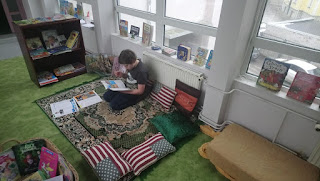
SERA ja Rohelise kooli projekti raames toimus jällegi midagi väga huvitavat.
On hea meel tõdeda, et meie õpetaja Kristel suudab innustada lapsi oma teadmiste ja õpetustega taimede võlumaailmaga tutvuma. Seekordsel projektinädalal oli just tema vedada seemnete muldapanek ja idandamine. Tuleb välja, et meil Gaia koolis on päris palju rohenäppe!
Päev varem olid lapsed kunsti töötoas ette valmistanud suure hulga tualettpaberirullidest maalitud kauneid topsikuid. Nendesse surusid väikesed sõrmed nüüd piisavas koguses mulda ning poetasid sinna sisse seemneid.
Ka munakarbid said kenasti mullaga täidetud ja seemneid täis poetatud.
Külvid said ka sildid külge, mis tehti kasutatud jogurtitopsidest.
Herned pandi idanema.
Seemneid oli väga palju erinevaid. Tilli, salatit, päevalille, saialille, basiilikut, spinatit, lambasalatit, erinevaid kapsaid, jne.
Näiteks märkasid lapsed, et peakapsa, nuikapsa, brokkoli ja lehtkapsa seemned on äravahetamiseni sarnased, kuigi see, mis taim sellest kasvab, on päris erinev.
Väga meeldisid peiulille seemned, mis näevad erilised välja.
Lapsed said teada, et suuremat seemet on võimalik ühekaupa mulda panna. Imeväikeste seemnete mulda saamiseks sai kasutada vette kastetud grilltikku, millele siis mõned seemned külge jäid. See oli väga täpne töö. Mullale oli vaja veel parajalt vett lisada ning seda sai siis peo vahel pigistades kontrollida.
Kogu see töö sai tehtud hoole ja armastusega ning nüüd jääb üle ainult seemnetopside eest hoolitseda, neid jälgida ja kasta ja kujutame juba ette, millise rõõmuga me esimesi taimehakatisi tervitame!
Our Green school project and SERA have so much in common and it makes the project life much easier.
It is a pleasure to admit that our teacher, Kristel, is able to inspire children to explore the magical world of plants with her knowledge and teachings. This time during the project week, she was leading the seeding and germination workshop. It turns out that we have so many green thumbs at Gaia school!
The day before, the children in the art workshop had prepared beautiful cups of painted toilet paper rolls. Now they could use those rolls to fill them with soil and put some seeds into.
Kids also used empty egg boxes to fill with soil and seeds.
The labels were made of used yoghurt cups.
One of the interesting things was germination of peas. We can't wait what happens to those seeds!
There were many different kinds of seeds. Dill, salad, sunflower, marigold, basil, spinach, lamb salad, various cabbages, etc.
For example, the children noticed that the seeds of cabbage, broccoli, and cauliflower are similar to each other, although the plant what grows is quite different.
Kids liked the seeds of tagetes that look so special.
The children learned that it was possible to put larger seeds into the soil one by one. To get small seeds, we could use a toothpick dipped in water and then some seeds get attached to it. It was a very precise job. It was still necessary to add water to the soil, and it could be controlled by squeezing the palm.
All this work has been done with care and love, and now we only have to take care of the seedlings, observe them and water them, and we can olny imagine the joy of welcoming the first plants!













